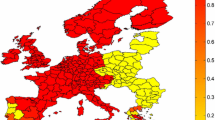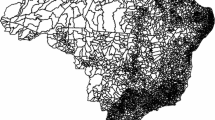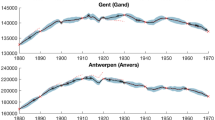Abstract
This paper examines how the volatility of local economies, represented by uncertainty over future land rents, affects urban sprawl. We develop a theoretic model that links sprawl to shocks to expected rent from future land development, among other factors. The econometric analysis draws upon panel data from US metropolitan areas. To measure urban sprawl, we construct a distinctive measure that captures the distribution of population density within metropolitan areas. Using a proxy for uncertainty over future land rents, we confirm the theoretic prediction that across US metropolitan areas, higher levels of uncertainty are associated with lower levels of sprawl.
Similar content being viewed by others
References
Alonso W (1964) Location and land use. Harvard University Press, Cambridge
Anas A (1978) Dynamics of urban residential growth. J Urban Econ 5: 66–87
Angrist JD, Pischke J (2009) Mostly harmless economics, an Empiricist’s companion. Princeton University Press, Princeton
Bar-Ilan A, Strange WC (1996) Urban development with lags. J Urban Econ 39: 87–113
Bartik TJ (1991) Who benefits from state and local economic development policies?. Upjohn Institute, Kalamazoo
Baum-Snow N (2007) Did highways cause suburbanization?. Q J Econ 122: 775–805
Blanchard O, Katz LF (1992) Regional evolutions. Brookings Papers on Economic Activity, pp 1–75
Brueckner JK, Fansler DA (1983) The economics of urban sprawl: theory and evidence on the spatial size of cities. Rev Econ Stat 65: 479–482
Brueckner JK, Thisse JF, Zenou Y (1999) Why is central Paris rich and downtown Detroit poor? An amenity-based theory. Eur Econ Rev (Elsevier) 43: 91–107
Burchfield M, Overman H, Puga D, Turner M (2006) Causes of sprawl: a portrait from space. Q J Econ 121: 587–633
Caballero RJ, Pindyck RS (1996) Uncertainty, investment, and industry evolution. Int Econ Rev 37: 641–662
Capozza DR, Helsley RW (1990) The stochastic city. J Urban Econ 28: 187–203
Capozza DR, Yuming Li (1994) The intensity and timing of investment: the case of land. Am Econ Rev 84: 889–904
Carruthers JI (2003) Growth at the fringe: the influence of political fragmentation in United States metropolitan areas. Papers Reg Sci 82(4): 475–499
Carruthers JI, Ulfarsson GF (2008) Does ‘Smart Growth’ matter to public finance?. Urban Stud 45(9): 1791–1823
Carruthers JI, Vias AC (2005) Urban, suburban, and exurban sprawl in the Rocky Mountain West: evidence from regional adjustment models. J Reg Sci 45: 21–48
Cunningham CR (2006) House price uncertainty, timing of development, and vacant land prices: evidence for real options in seattle. J Urban Econ 59: 1–31
Cutsinger J, George G, Wolman H, Hanson R, Towns D (2005) Verifying the multi-dimensional nature of metropolitan land use: advancing the understanding and measurement of sprawl. J Urban Aff 27: 235–259
Davis A, Palumbo MG (2008) The price of residential land in large US cities. J Urban Econ 63: 352–384
Fallah, B, Partridge MD, Olfert MR (forthcoming) Urban sprawl and productivity: evidence from US metropolitan areas. Papers in Regional Science. doi:10.1111/j.1435-5957.2010.00330.x
Fischel WA (1985) The economics of zoning laws: a property rights approach to American land use controls. Johns Hopkins University Press, Baltimore
Fulton WR, Pendall MN, Harrison A (2001) Who sprawls most? How growth patterns differ across the US. Brookings Institution, Washington
Galster GR, Hanson HW, Coleman S, Friebage J (2000) Wrestling sprawl to the ground: defining and measuring an elusive concept. Fannie Mae, Washington
Glaeser EL, Kahn ME (2004) Sprawl and urban growth. Handb Reg Urban Econ 4: 2481–2527
Harrison D, Kain J (1974) Cumulative urban growth and urban density functions. J Urban Econ 1: 61–98
Holland AS, Ott SH, Riddiough TJ (2000) The role of uncertainty in investment: An examination of competing investment models using commercial real estate data. Real Estate Econ 28: 33–64
Irwin EG, Bockstael NE (2004) Land use externalities, open space preservation, and urban sprawl. Reg Sci Urban Econ 34: 705–725
Irwin EG, Bockstael NE (2007) The evolution of urban sprawl: evidence of spatial heterogeneity and increasing land fragmentation. Proc Natl Acad Sci (PNAS) 104: 20672–20677
Jordan S, Ross JP, Usowski KG (1998) US suburbanization in the 1980s. Reg Sci Urban Econ 28(17): 611–627
Karlin H, Taylor M (1975) A first course in stochastic processes. Academic Press, New York
Lang R (2003) Open spaces, bounded places: does the American west’s arid landscape yield dense metropolitan growth?. Hous Policy Debate 13: 755–778
Lopez R, Hynes H (2003) Sprawl in the 1990s: measurement, distribution, and trends. Urban Aff Rev 38: 325–355
Margo RA (1992) Explaining the postwar suburbanization of population in the United States: the role of income. J Urban Econ 31: 301–310
McDonald R, Siegel D (1985) Investment and the valuation of firms when there is an option to shut down. Int Econ Rev 26: 331–349
McDonald R, Siegel D (1986) The value of waiting to invest. Q J Econ 101: 707–727
McFarlane A (1999) Taxes, fees, and urban development. J Urban Econ 46: 416–436
Mills ES (1967) An aggregative model of resource allocation in metropolitan area. Am Econ Rev 197: 197–210
Mills DE (1981) Growth, speculation and sprawl in a monocentric city. J Urban Econ 10: 201–226
Mills ES (2006) Sprawl and jurisdictional fragmentation. Brookings-Wharton Papers on Urban Affairs 231–256. doi:10.1353/urb.2006.0023
Mills ES, Price R (1984) Metropolitan suburbanization and central city problems. J Urban Econ 15: 1–17
Moel A, Tufano P (2002) When are real options exercised? An empirical study of mine closings. Rev Financ Stud 15: 35–64
Moretti E (2010) Local labor markets. IZA Discussion Papers: 4905
Muth RF (1969) Cities and housing: the spatial pattern of urban residential land use. University of Chicago Press, Chicago
Nechyba T, Walsh R (2004) Urban sprawl. J Econ Persp 18: 177–200
Ottensmann JR (1977) Urban sprawl, land values and the density of development. Land Econ 53: 389–400
Paddock JL, Siegel D, Smith JL (1988) Option valuation of claims on real assets: the case of offshore petroleum leases. Q J Econ 103: 479–508
Partridge MD (2005) Does income distribution affect US state economic growth?. J Reg Sci 45: 363–394
Partridge MD, Rickman DS (2003) The waxing and waning of US regional economies: the Chicken-Egg of jobs versus people. J Urban Econ 53: 76–97
Partridge MD, Rickman DS (2006) Fluctuations in aggregate US migration flows and regional labor market flexibility. South Econ J 72: 958–980
Partridge MD, Rickman DS (2008) Does a rising tide lift all metropolitan boats? Assessing poverty dynamics by metropolitan size and county type. Growth Change 39: 283–312
Pindyck R (1991) Irreversibility, uncertainty, and investment. J Econ Lit 29: 1110–1148
Plantinga AJ, Lubowski RN, Stavins RN (2002) The effects of potential land development on agricultural land prices. J Urban Econ 52: 561–581
Sigelman L, Heing J (2001) Crossing the great divide—race and preferences for living in the city versus the suburbs. Urban Aff Rev 37: 3–18
Stock JH, Yogo M (2005) Testing for weak instruments in linear IV regression. In: Andrews DW, Stock JH (eds) Identification and inference for econometric models: essays in honor of Thomas Rothenberg. Cambridge University Press, Cambridge, pp 80–108
Tiebout CM (1956) A pure theory of local expenditure. J Political Econ 64: 416–424
Titman S (1985) Urban land prices under uncertainty. Am Econ Rev 75: 505–514
Van Nieuwerburgh S, Weill P-O (2006) Why has house price dispersion gone up? NBER Working Paper #12538
Wu J (2001) Environmental amenities and the spatial pattern of urban sprawl. Am J Agric Econ 83: 691–697
Wu J (2006) Environmental amenities, urban sprawl, and community characteristics. J Environ Econ Manag 52: 527–547
Wu J (2010) Economic fundamentals and urban-suburban disparities. J Reg Sci 50: 570–591
Author information
Authors and Affiliations
Corresponding author
Rights and permissions
About this article
Cite this article
Fallah, B., Partridge, M. & Olfert, M.R. Uncertain economic growth and sprawl: evidence from a stochastic growth approach. Ann Reg Sci 49, 589–617 (2012). https://doi.org/10.1007/s00168-011-0466-0
Received:
Accepted:
Published:
Issue Date:
DOI: https://doi.org/10.1007/s00168-011-0466-0




